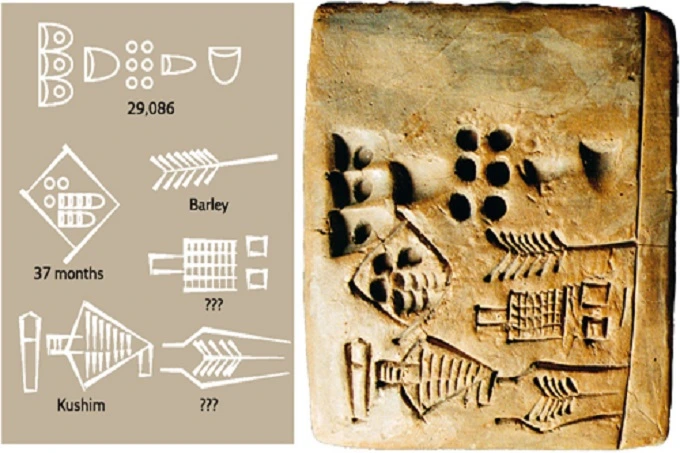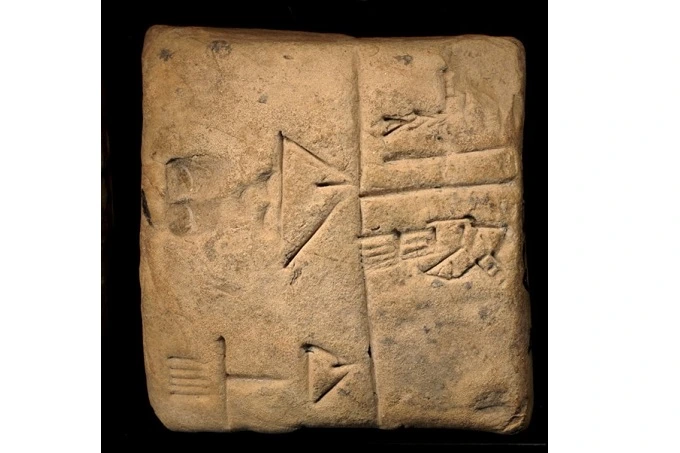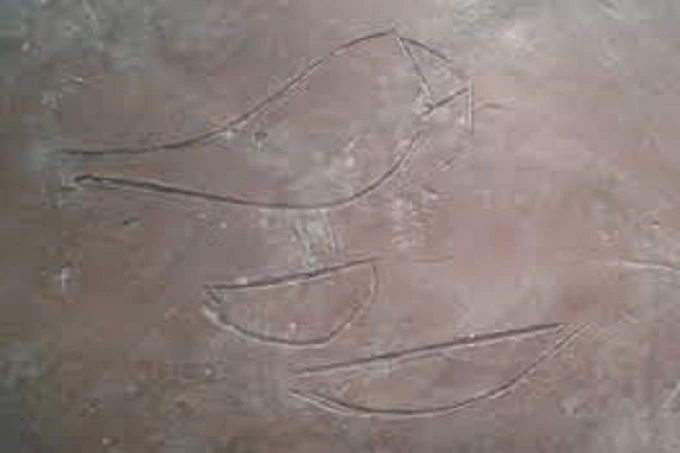What was the first name ever inscribed by the Sumerians on a tablet?

Since the beginning of recorded history, when humans first started populating the Earth, they have known each other by their names. Because there was no written language, there are many names that will never be known to anybody.
The Sumerians are credited as being the first people ever to record sound. Cuneiform writing was first developed in ancient Mesopotamia as a method of information recording and dated back over 6,000 years.
The clay tablets that have been preserved from this technologically accomplished society include a wide range of information, ranging from the record of economic activities to artwork. On one of these tablets, researchers have discovered what is believed to be the first name ever written down in the history of humanity.
Record keeping

For instance, archaeologists uncovered this clay tablet in the ancient Sumerian city of Uruk. It is 8 centimeters by 8 centimeters and measures in. It was created about the year 3100 BC. It is a record that keeps track of the specifics of a barly transaction. The pictograms decipher the receipt of the antique goods and expose all of their hidden meanings.
There is a sheaf of barley located in the middle of the lowest portion of the tablet. A brick structure with a chimney can be seen to its left and seems to be a brewery. The sheaf is also shown within the vessel, which indicates that beer will be produced from the vessel’s contents. At the very bottom of the plaque is written the total number of sheaves bought. On the left, in addition to a number of other items, an indication is given of the period in which the products were delivered. It may be deduced from the presence of three bigger circular indentations as well as seven smaller ones that 29,086 measures of barley were obtained in 37 months.
Two symbols may be seen in the top left corner, just over the jug that contains the sheaf of grain. They probably sound somewhat like the name “Kushim.” Scholars think that this is a signature in which the name of the seller or the accountant is indicated. After all, the term is located at the end of the sentence, and the reasoning behind this concept is fairly sound. According to this belief, Kushim was the first recorded name in writing form.
Name or title?
It is assumed that Kushim was either a specific person or the title of an officeholder in its generic form. Because the cuneiform letters “KU” and “SIM” were not supplied with any context. It is impossible to establish if such sign combinations represent a person, the person’s office, or an entire institution. However, it is possible that such sign combinations denote a person’s office.
The cultivation of barley, as well as its warehousing, were within Kushim’s control. On some of the tablets, the distribution of barley to many officials is shown as a number of separate debits. In contrast, the total amount is shown on the other side of the tablet as a single credit for the release of Kushim’s responsibility. On the obverse of a rather straightforward account, various quantities of grain are shown to have been charged to three different officials. At the same time, on the reverse, Kushim is given credit for the entire quantity of barley delivered to the officials. On the other hand, the opposite interpretation might equally be taken as Kushim’s version of events.
The obverse of certain tablets depicts the many elements that go into making beer, such as malt and hops, while the reverse depicts the numerous types of beer that come out of the brewing process. On one of the tablets, it is shown that Kushim gave 14,712 liters of barley to four officials, in exchange for which they were released correctly.
The second contender for the championship
A name inscribed on a tablet discovered in Iraq is another candidate for the title of the oldest name. Archaeologists at the ancient city of Shurrupak in Iraq, which is today known as Jemdet Nasr, discovered it and determined that it was from around the same time. The consensus among scientists is that it is not quite as old. The lettering on it is quite clear and unmistakable. It has a name that may be read with ease.

The following is written in the inscription found on this ancient document: “Two slaves that belong to Gal-sal: En-pap-x and Sukkalgir.” The names of the world’s first inhabitants are not those of illustrious kings, famous prophets, or terrifying warlords; instead, they are the names of ordinary people. A simple accountant, a slave master, and his indentured servants.
The first of the known names of the rulers belong to the king of Upper Egypt, Iry -Hor. This monarch ruled Egypt and controlled Abydos and the region of the Thinites. Some Egyptologists claim that Iri-Hor also owned much of the land in the Nile Delta. This name dates back to the 32nd century BC, making it almost contemporary with those named Kushim and Gal-Sal.
At first, when this tablet was found, many Egyptologists could not believe that Iri-Hor was a king. After all, his name was not listed in any of the historical documents that indicate the names of the rulers of Egypt. Only when the tomb of Iri-Hor in Abydos was discovered were all doubts dispelled. Many clay and ceramic vessels were found there, where his name was inscribed.
When this tablet was initially discovered, many Egyptologists could not accept that Iri-Hor had ever held the position of king. After all, his name is not included in any historical records or books that provide a list of Egypt’s pharaohs and other rulers. It wasn’t until the tomb of Iri-Hor was found at Abydos that all of the lingering questions were answered. Several earthenware and ceramic vessels had his name inscribed on them that were discovered there.

The most important evidence was gathered in 2012. On a tablet discovered on Mount Sinai, his pictogram had been engraved into it. It displayed a boat along with the term “Inebu-Hedges,” which literally means “white walls,” and was the name used to refer to Memphis in its early days. To this day, scholars believe that Iri-Hor was the earliest Egyptian ruler, reigning before the dynasties established by the pharaohs.
According to statistics, the surname Kushim is among the 2,168,711 most common globally. One in every 95 million people uses it. Kushim is also the 910,230th most popular given name in the world.




